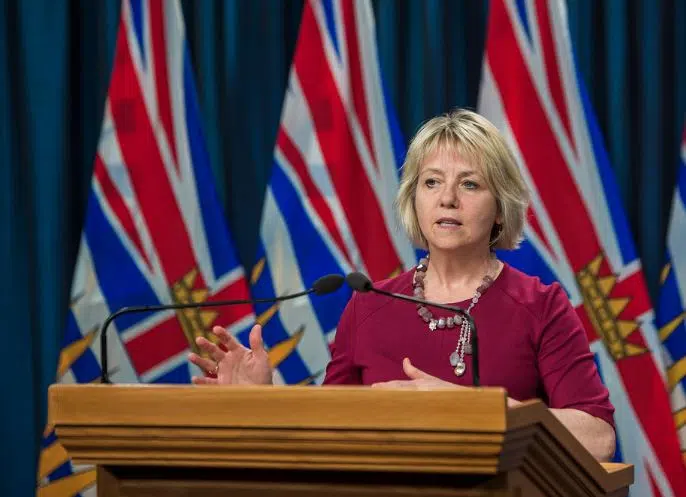
Dr. Bonnie Henry during a COVID-19 update briefing. (Photo via BC Government)
While outdoor gatherings of up to 10 people are now permitted in British Columbia, the province’s top doctor is reminding people to not travel outside their communities.
Dr. Bonnie Henry says in the weeks ahead, the focus will still be on essential travel. She called the plan to potentially ease some restrictions in the weeks ahead as “slowly turning up the dial” rather than “flipping a switch.”
“What we need to do is stay local. Explore your local community. Explore your region,” she said. “I do think, over March break, if you are a family and you’re going to your cabin and it’s self-contained, that’s okay. But we really do need to stick to our households.”
“If you need to go, focus on small and staying with your family, your household, exploring your neighbourhood and doing day trips. There are many things that we can do in day trips.”
If you are gathering outside with people outside your household, Henry says to ensure you remain physically distant from them, and wear a mask if required.
She also says people should avoid travelling to or from some of the COVID hot spots in this province, especially those in parts of Fraser Health and in some areas of Northern Health.
“There are areas where we have a lot of transmission happening and we do not want people to travel from those areas to an area of low risk and we don’t want people to visit an area that is high risk right now because those communities are trying to manage their outbreak,” Henry added.
She’s recommending you check the B.C. Centre for Disease Control website to identify areas that are high risk. The darker the colour on the map, the higher number of infections per 100,000 people.
The most recent data showed an even 100 new cases of COVID-19 in the Kamloops local health area during the week of Feb. 28 to March 6. It was the region with the most COVID-19 cases across all of Interior Health.
Echoing the words of Dr. Bonnie Henry, the medical health officer for Kamloops is encouraging people to spend time outside this spring break.
Speaking on NL Newsday, Dr. Carol Fenton says while there have been exposure events in Kamloops-area schools, there hasn’t been widespread transmission in a school setting.
“March break is coming up and spring is coming and so the best thing that you can do both after school or on time off is to spend time outside,” Fenton said. “You know its great to get some physical activity and some fresh air, but being outside is one of the safest places to be from an infection prevention stand point.”
Fenton’s comments come as provincial health officials are reminding kids to avoid spending time with people who are not in their school cohorts.
The Superintendent of the Kamloops-Thompson School District is also reminding people to follow the COVID-19 public health guidelines over spring break.
“This has been a year now and I think the vast majority of people have worked very hard to adhere to the guidelines,” Terry Sullivan told NL News. “We have a duty to protect one another. Enjoy the outdoors, enjoy the break but we still are in the middle of a pandemic and so we still have to take precautions.”
There was an increase in school exposures when students returned to class after the winter break and Sullivan says its why he is concerned about COVID cases in schools increasing after spring break.
Last month, he told NL News there were 42 COVID-19 exposures in the first 28 school days after the winter break compared to just five exposures in 69 school days before the winter break.
“We’re seeing a sense of normalcy. We can see now that some sense of normalcy is going to return but that is still going to be a while,” Sullivan added.















